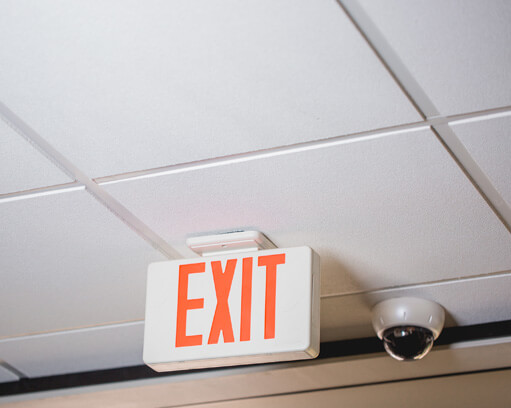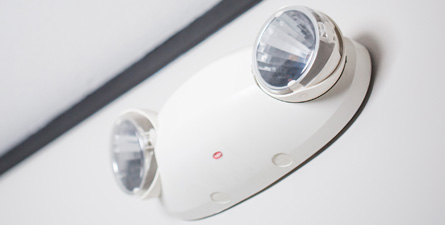
Emergency lights, exit signs, and panic doors are some of the most important safety devices in your business. While fire alarm systems communicate an emergency and fire sprinklers extinguish fires, exit and emergency lights are designed to guide you and your employees to safety in the event of an emergency. Emergency and exit path lighting are required in all commercial buildings and are specifically designed to save lives. In the event of a power failure or other service interruption, your employees will utilize the emergency and exit lights to get to safety.
Benefits

Connect with Impact and benefit from:
- Code compliance
- 90-minute testing / push-button testing
- Bulb and battery replacement
- Emergency / Exit light installations
- Panic alarm / Exit bar testing & installation
Maintenance Schedule
Monthly
- Ensure emergency lighting is in its designated place
- Inspect housing for physical damage
- Conduct push test switch for 30 seconds
- Verify lamps are illuminated and aimed in correct direction
- Maintain monthly log for inspection by the authority having jurisdiction (AHJ)
Every Year
- Conduct a thorough examination of the unit
- Test the battery and lighting system for the required 90 minutes
- Check the condition and voltage of the battery and verify manufacturer date
- Check AC/DC lamps or bulbs for damage and proper operation
- Verify charging circuit is operational and working properly
- Apply emergency lighting test label to each light upon completion
Inspection Process
During our Emergency Light inspections, our technicians will:
- Inspect the lighting system to determine whether it is in service and in satisfactory condition in accordance with NFPA standards
- Conduct a complete test of the lighting system to ensure it will illuminate a minimum of 90 minutes (OSHA, NFPA and NEC minimum standards)
- Adjust the PC board float voltage to ensure extended life of the batteries and other key components
- Inspect all bulbs and lamp heads to ensure they are operational and meet lighting requirements
- Clean all battery terminals and leads
- Survey the emergency lights and exit signs for proper placement
- Check the energy efficiency of the bulbs and lamps
- Tag or label devices as required and perform all required record keeping
- Identify potential detrimental site conditions that could compromise the performance of mechanical and/or electronic components of the system
- Compile a complete report of the inspection, explaining any deficiencies and recommending corrective action in accordance with recognized codes for care and maintenance





